Indian Folk Painting
In Indian art and culture Indian folk painting is a vibrant and multifaceted art form that has its roots in the regional cultural traditions of India. Every folk painting style captures the customs, beliefs, and way of life unique to the area—many of which have been handed down through the years.
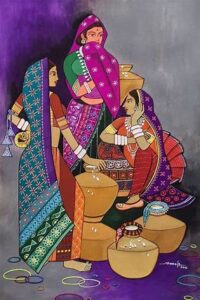
Indian Folk Painting. Famous forms include the elaborately patterned and vividly colored Madhubani from Bihar, the straightforward, monochromatic Warli from Maharashtra, and the intricately detailed Pattachitra from Odisha and West Bengal, which are renowned for their mythological themes and fine workmanship.
Indian Folk Painting. These paintings are usually made on walls, cloth, scrolls, or paper, and they frequently use natural colors that come from plants, minerals, and other organic sources. The depictions of nature, animals, and social rituals are among the themes, as are stories from religion and mythology.
Madhubani Painting is Indian Folk Painting in Indian art and culture
Traditionally done by women around Madhubani city of Bihar, this painting is also called Mithila painting. The themes of these paintings are similar and are generally inspired by Hindu religious motifs such as Krishna, Rama, Durga, Lakshmi, Shiva etc., the pictures in these paintings are indicative for example fish are good luck and reproductive inability.
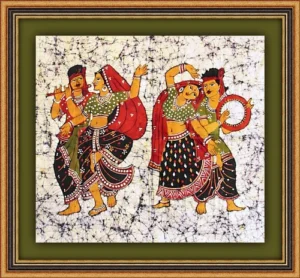
In Indian art and culture Indian Folk Painting. are produced depicting auspicious occasions such as births, marriages and festivals. Traditionally, they are made with rice paste and vegetable dyes on a base coated with cow dung and clay.
This base has changed to handmade paper cloth and canvas.
The double row edge, the use of dark colors, ornate kosha patterns and exaggerated facial postures are common features of this painting.
In Indian art and culture, The origin of Madhubani painting is believed to be during the Ramayana period when the king of Mithila asked his kin to paint their walls and courtyards on the occasion of the marriage of Sita and Rama.
The skill of Madhubani painting has been passed down from generation to generation. In 1970, when the President of India honored Jagdamba Devi with the award, this art gained recognition.
The paintings include Bahua Devi, Bhartiya Dayal, Ganga Devi, Maha Sundari Devi and Sita Devi. It has been confined to a specific terrain and hence has also been given the status of GI Geographical Indication.
Tikuli Art is also an Indian Folk Painting
A unique art of Bihar, the word Tikuli is a satanic relationship used for women to bindi between their eyebrows. Under this art, painting is done on hardboard, it is cut into different shapes.
Patachitra painting is a Indian Folk Painting
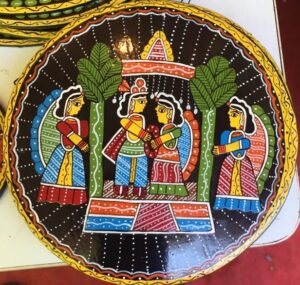
The interpersonal painting of Odisha called Patachitra is named after the Sanskrit Shabad Pat i.e. canvas cloth and picture.
This painting displays a mixture of classical and folk elements with more inclination towards folk elements.
The basis of this painting was the treated cloth in which the colors used were obtained from natural sources such as burnt coconut shells, Hingula, Rama Raja and island kajal etc.
No pencil and charcoal were used, brushes were used to draw a fine line with red and black colors, followed by colors. The painting consisted of a frame made of fine work. After drawing the lines, lacquer paste was applied on the painting to provide a bright décor.
The themes of the art are inspired by Jagannath and Vaishnavism and sometimes even Shakti Shiva. Raghu Rajpur in Odisha is known for this art form. Patachitra painting displays images that are similar to the old murals of the state. Which is mainly found in Pari and Konark. The patachitra made on dates is known as Talpatachitra.
Patua Art is an Indian Folk Painting
The Patua art of Bengal is about 1000 years old, it originated as a rural tradition of painting narrating the Mangal Kavyas or good stories of Hindu gods and goddesses. Many generations then Shakrol painters or patuas used to travel to different villages to sing the stories contained most of the Patuas being Muslims. Traditionally these were painted on cloth and narrated religious stories.
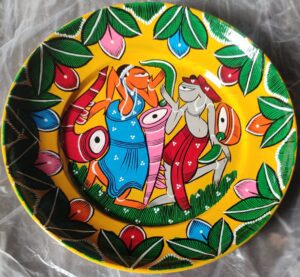
Nowadays these are stitched together paper sheets painted with poster colors, used to comment on political and social issues.
This Patwa Midnapore area now belongs to Murshidabad, North and South 24 Parganas and Birbhum districts.
Paitkar Paintings
Paitkar paintings or scroll paintings made by the tribal people of Jharkhand are considered to be one of the ancient styles of painting in the country. The cultural relation of this older form of painting is Maa Mansan, one of the most popular goddesses of the Bengali household.
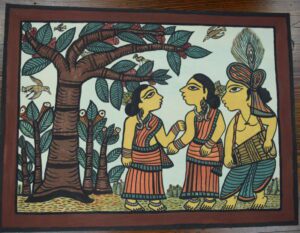
Kalamkari Painting
Its name is related to the pen which is used to produce very beautiful paintings In Indian art and culture . The stylus used is made of bamboo with pointed tips which is used to regulate the effect of colors. Its base is cottoning fabric while the colors used are made from vegetable dyes.
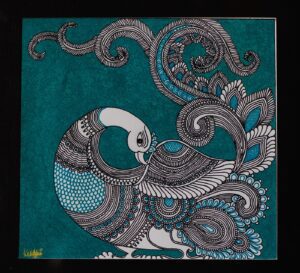
Inside the head of art is Srikala Hasti and Machilipatnam in the state of Andhra Pradesh. Free-hand paintings are created which are inspired by Hindu mythology Kalamkari painting existed even during the Vijayanagar Empire. It has got the status of geographical indication.
Warli painting
The name of this painting has been read by three thousand people who carried the tradition of this painting from 2500 BC, these indigenous people living on the Gujarat-Maharashtra border are called Worli. These desi people living on the Gujarat-Maharashtra border are called Worli, this painting is intricately similar to the KBC paintings of Bhimbetka in Madhya Pradesh. The central motif of ritualistic paintings is a square surrounded by scenes depicting fishing, hunting, farming, dancing, animals and trees festivals etc.
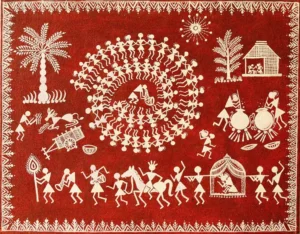
Under the goddesses Palaghat is depicted the goddess of fertility and under the male deities the souls in human form are depicted. Clay, branches and cow dung are used to form the base of the painting which gives it red ochre color. Only white pigment is used for painting which is made up of gum and rice steps. Paintings on the walls are made for auspicious occasions like harvesting and marriage
Due to the popularity of Warli paintings, white poster colors are being made on red or black background on new cloth.
Thangka Painting is a Indian folk painting
Presently Thanka painting belongs to the Indian state of Sikkim Himachal Pradesh Ladakh Arunachal Pradesh.
It is basically used as a means of reverence to the tenets of Buddhism. The skill of this painting produced by the Buddhist was passed down from generation to generation.
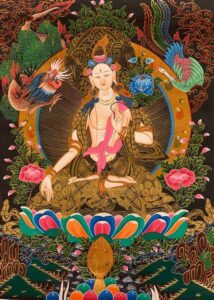
The painting is painted with natural vegetable dyes or mineral dyes on the basis of cotton canvas. For example, red is the sign of intensity of emotion, whether it is love or hate, the golden color is for life and birth. White color represents peace, black color represents anger, green color represents consciousness and yellow color represents compassion. After the painting is completed, it is usually covered in colorful silk bell cloth.
Manjusha Painting is also Indian folk painting
This form of art is related to the Bhagalpur region of Bihar, it is also called Angika art where the reference of Anga is to a Mahajanapada.In this, the design of the serpent is always scholarly, it is also called just painting, this painting is produced on jute and paper boxes.
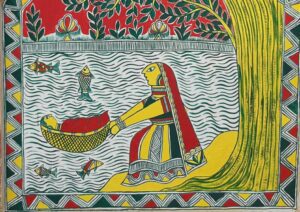
Fad Painting is a Indian folk painting
Found mainly in Rajasthan and is a painting made on cloth to be wrapped. It is religious in nature and depicts local gods like Pabuji and Devnarayan. In this, the hood is painted with colors on a long piece of cloth, it is 15 feet or 30 feet long. Human figures have large eyes and round faces, they describe elegance and happiness, in which the scenes of processions are normal.
Cherial scroll Paintings
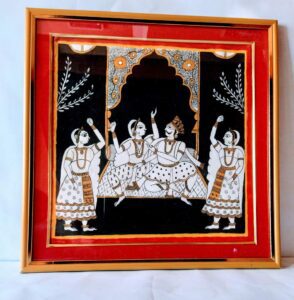
This is a type of carving art from Telangana. Wrapno is portrayed by the folk singing community as a continuing story or folk song, its common theme is Hindi epic and mythology. Wrapping paintings are used by artists to go to various places to express stories with music. Their size is large, whose height can go up to 45 feet, it was given the status of Geographical Indication in 2007.
Pithora paintings is a Indian folk painting
These paintings are made by some tribal communities of Gujarat and Madhya Pradesh and their use is said to be religious and spiritual. These are painted on the walls of houses to bring peace and prosperity. They are carved as ceremony on special family occasions, among which the distribution of livestock, especially horses, is common.
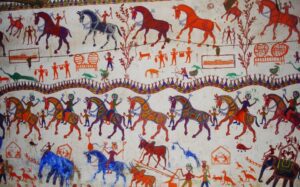
Painting Saura Paintings Odisha is also an Indian folk painting
Painting is made by the Sora tribe of Odisha, M. Warli is similar to painting, it is a past painting and ritual is assayed. Sora mural painting is dedicated to Idital, the chief presiding deity of Sorons. The painters are mainly carved with white; the background color is red or yellow. Human shapes are geometry or stick-like, this design has come into fashion in recent times. And many T-shirts depict these designs of Sora Sally on women’s wear.

conclusion
In Indian art and culture Indian folk painting is a vibrant representation of the country’s diverse communities, steeped in cultural heritage and tradition. In Indian art and culture These artistic expressions—such as Madhubani, Warli, and Pattachitra—embodi the lives, ideologies, and narratives of their creators.
Indian folk painting. They are colorful and intricately designed, preserving history, mythology, and regional customs as they are passed down through the generations. These paintings continue to be an effective storytelling and cultural continuity tool despite contemporary influences. In Indian art and culture Their ability to bridge the past and present and provide a visual narrative of India’s rich and complex cultural identity is what makes them so appealing to this day.
